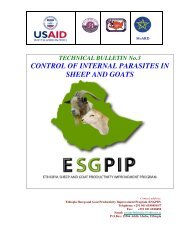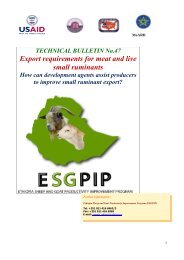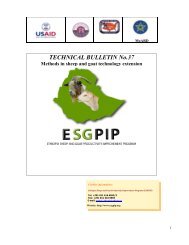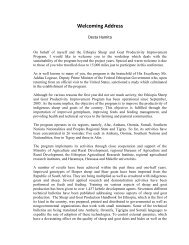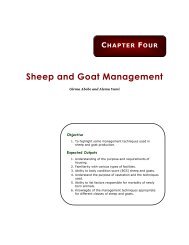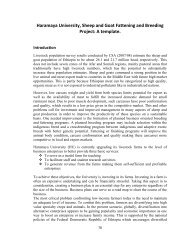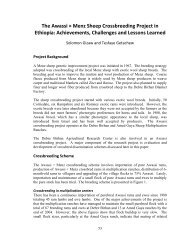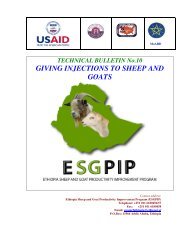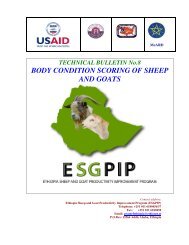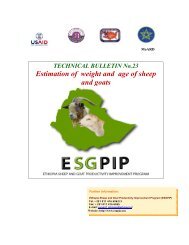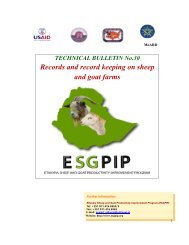Genetic Improvement of Sheep and Goats - esgpip
Genetic Improvement of Sheep and Goats - esgpip
Genetic Improvement of Sheep and Goats - esgpip
- No tags were found...
Create successful ePaper yourself
Turn your PDF publications into a flip-book with our unique Google optimized e-Paper software.
84S O L O M O N A N D K A S S A H U N• <strong>Sheep</strong> <strong>and</strong> goats may show variation in productivity even when they are provided with similarmanagement. Such variation which exists when animals are kept under similar management can be passedto their <strong>of</strong>fspring.• Selection allows animals with superior performance to be the parents <strong>of</strong> all or most <strong>of</strong> the next generationwhile those with inferior performance will not be allowed to mate.• Some production traits have high heritability (greater genetic variability within the population <strong>and</strong> moreresponsive to selection) while others show low heritability.• When there is no sizeable variation among animals <strong>of</strong> a given genotype or when the heritability <strong>of</strong> adesired trait is low, crossbreeding or replacement <strong>of</strong> the local animals could be considered.• In a crossbreeding program, introduced animals <strong>and</strong> breeds should be selected very carefully for their ownadaptability <strong>and</strong> the adaptability <strong>of</strong> their crossbred progenies.Designing breeding programsA breeding program can be defined as the set <strong>of</strong> activities <strong>and</strong> decisions undertaken by a breeder (producer)towards improving animal performance for a given trait. There are a series <strong>of</strong> steps to be followed to achievethe breeding aim from the breeding plan.Approaches utilizing the potential <strong>of</strong> higher-producing or better-adapted indigenous livestock breeds must bedeveloped whenever possible. Realistic ways <strong>of</strong> breed improvement must be chosen <strong>and</strong> applied in thecontext <strong>of</strong> environmental constraints, socioeconomic dem<strong>and</strong>s <strong>and</strong> within the management resourcesavailable. Aspects <strong>of</strong> sustainability <strong>and</strong> provision <strong>of</strong> future genetic diversity are critical. A basic principle t<strong>of</strong>ollow should be based on the assumption that there is no better way <strong>of</strong> conserving a breed for futuregenerations than consistently keeping the breed or population viable by using an efficient, dem<strong>and</strong>-drivenlong-term breeding program suitable to commercial or cultural needs.An important feature <strong>of</strong> a genetic improvement program is that the effects <strong>of</strong> selection accumulate over time.The economic benefits <strong>of</strong> selection also accumulate. Breeding programs should therefore be seen asinvestments for sustainable improvements <strong>of</strong> animal stock <strong>and</strong> its potential to produce food or other goods.6.2. Breeding ObjectivesAny breeding program for sheep <strong>and</strong> goats should be implemented to achieve a certain clearly definedobjective. Therefore, the first step in a breeding program is to define realistic <strong>and</strong> attainable objectives.The main objective is to maximize output (meat, milk, wool, skin) per unit input. The quality <strong>of</strong> animalproducts must target the requirements <strong>of</strong> the end-user or target market. This may be an export or domesticmarket. Meat is the most important product <strong>of</strong> small ruminants in Ethiopia. Milk is also a highly valuedproduct in some pastoral, agro-pastoral or mixed agricultural areas. The quantity <strong>of</strong> meat produced dependson the number <strong>and</strong> weight <strong>of</strong> surplus animals at age <strong>of</strong> sale. The importance <strong>of</strong> reproduction rate must bestressed in relation to the number <strong>of</strong> meat animals for sale.Meat quality is poorly defined in Ethiopia. The market may require lean meat or a fat tail that would be adelicacy in some cases <strong>and</strong> there may be specific flavor requirements in some areas. Skins are valuablebyproducts from sheep <strong>and</strong> goats used for meat but there is no clear definition <strong>of</strong> skin quality within a breed.Currently, the only wool produced by some sheep breeds in Ethiopia is the coarse (carpet) wool. The woolcolor found in Ethiopia could be desirable, e.g., for making patterns in carpet production, as opposed toapparel wool where white wool is usually preferred.The most important measure <strong>of</strong> productivity for milk is yield per lactation or per year. Quality is lessimportant as sheep <strong>and</strong> goat milk in most cases is for home consumption. Goat milk may be desired because<strong>of</strong> its flavor, <strong>and</strong> sheep milk because <strong>of</strong> its high content <strong>of</strong> solids.Ethiopia <strong>Sheep</strong> <strong>and</strong> Goat Productivity <strong>Improvement</strong> Program
G E N E T I C I M P R O V E M E N T85To ensure genetic improvement for a particular trait, the available variation in the current population <strong>and</strong> theheritability <strong>of</strong> the trait should be known. The selection intensity should be determined to achieve the targetwithin the time limit envisaged.ExampleSuppose the export market requires sheep with an average live weight <strong>of</strong> 30 kg as opposed to thecurrent level <strong>of</strong> 27 kg.Breeding objective: Increase the number <strong>of</strong> animals qualifying for the export market through geneticimprovement <strong>of</strong> weight at marketing (e.g., yearling weight) with no or minor changes in management.Breeding goal: Improve the average yearling weight <strong>of</strong> the breed from 27 to 30 kg (market requirement).6.3. Breed SelectionThere is a large variation among sheep <strong>and</strong> goat breeds in Ethiopia <strong>and</strong> the world. Different breeds havedifferent environmental adaptability. Animals which are adapted to cool areas may not be suitable to hotareas. Animals which have evolved within a certain area are usually better adapted to that particular areathan other breeds. Therefore, whenever possible, it would be wise to make use <strong>of</strong> such animals inimprovement programs. In such programs, productivity improvement should come through selection <strong>and</strong>better management. Introduction <strong>of</strong> other animals (breeds) may be considered if their own – or that <strong>of</strong> theircrosses with local breeds – adaptability to the area is proven <strong>and</strong> if their performance shows clear superiorityto local animals under similar management conditions.Selection among breeds must be based on performance data collected from groups raised in the sameenvironment (cohorts). Comparisons need to be made in the actual environment in which animals will beraised, not on experimental stations. Comparisons must be thorough to give realistic estimates <strong>of</strong> not onlylifetime production but also reproductive, mortality <strong>and</strong> morbidity rates.6.4. Selection <strong>of</strong> Breeding AnimalsYou must develop a clear idea about the merits <strong>of</strong> individual traits to be successful in genetic selection. Forselection to be effective, the selected traits must be: heritable (capable <strong>of</strong> being transmitted from parents to<strong>of</strong>fspring), variable (differences must exist between animals for that trait), <strong>and</strong> measurable. Weight, forexample, is an easy trait to measure because all that is needed is a weighing scale. Traits to be considered ina sheep <strong>and</strong> goat selection program include those that will enhance meat, wool, <strong>and</strong> milk production.Where small ruminants are kept primarily for meat production, selection will be on the number <strong>and</strong> weight <strong>of</strong><strong>of</strong>fspring weaned per female per year. The number <strong>of</strong> <strong>of</strong>fspring born per flock per year can be increased bydecreasing the number <strong>of</strong> females which fail to lamb/kid, by increasing litter size, or by increasing thefrequency <strong>of</strong> parturition. Females which fail to produce <strong>of</strong>fspring after consecutive opportunities should beculled. With proper selection, it is possible to realize a sizeable increase in litter size. The acceptability <strong>of</strong>twins depends on the environment (particularly nutrition) <strong>and</strong> management system. Weights at birth,weaning, six months <strong>and</strong> one year are important in selection <strong>of</strong> animals for meat. Weight at birth would havean additional influence on survival <strong>of</strong> animals.For wool sheep, selection is based on weight <strong>of</strong> fleece. Additionally, staple length could be important. Ingeneral, selection for increased fleece weight will also result in a longer staple, but it might be necessary to<strong>Sheep</strong> <strong>and</strong> Goat Production H<strong>and</strong>book for Ethiopia
86S O L O M O N A N D K A S S A H U Npay particular attention to staple length for those sheep used for this purpose. Other wool quality aspects,such as crimp, diameter, etc., may not be important in Ethiopia, at least in the near future.Selection <strong>of</strong> animals for milk is in terms <strong>of</strong> quantity <strong>of</strong> milk produced per year. This is a function <strong>of</strong> quantity<strong>of</strong> milk per lactation, lactation length <strong>and</strong> parturition interval.Animals to be used for breeding purposes should be selected carefully <strong>and</strong> superior animals should beidentified accurately. <strong>Sheep</strong> <strong>and</strong> goats can be selected based on records <strong>of</strong> performance <strong>and</strong> visual appraisal.Selection based on records is the best way to achieve good results. Additional visual appraisal <strong>of</strong> the selectedanimals is advantageous. Visual appraisal <strong>of</strong> a contemporary group <strong>of</strong> animals may be considered whererecord keeping is not practical or is nonexistent. Visual identification <strong>of</strong> superior animals is less successfulcompared to selection based on records. Differences among animals <strong>of</strong> the same age from similar dams(parity, age, condition) kept under similar management serve as indicators <strong>of</strong> genetic variability that can beexploited in a breeding program.6.4.1. Visual appraisalSelection <strong>of</strong> sheep <strong>and</strong> goats for breeding purposes based on visual observation is done by looking at theappearance, conformation <strong>and</strong> presence or absence <strong>of</strong> defects in the animal.Appearance: Only an animal which is active, alert, healthy <strong>and</strong> attractive in appearance should beconsidered for selection.Conformation: <strong>Sheep</strong> <strong>and</strong> goats to be used for various purposes would have different conformations.Animals meant for milk purposes have a different conformation than animals meant for meat. There are nospecialized breeds in Ethiopia <strong>and</strong> animals are generally dual-purpose breeds. However, in areas where milkis an important product, it is wise to select animals with a conformation conducive for milk production. Milkanimals should have a larger tract <strong>and</strong> udder. They have longer, thinner necks <strong>and</strong> a wedge-shapedappearance. Meat animals, on the other h<strong>and</strong>, have a stockyappearance <strong>and</strong> tend to have a rectangular shape.Defects: <strong>Sheep</strong> <strong>and</strong> goats to be used for breeding should befree <strong>of</strong> defects, particularly those <strong>of</strong> genetic origin,including defects <strong>of</strong> legs, teeth <strong>and</strong> testes. In a number <strong>of</strong>goat breeds, polledness is associated with reduced fertility.Polledness in an otherwise horned goat breed should,therefore, be selected against.Legs: Legs <strong>of</strong> sheep <strong>and</strong> goats (particularly males) shouldnot be extremely hocked or curved. The rear (hind) legsshould be wide apart <strong>and</strong> straight when viewed from behind. Poor leg conformation is usually <strong>of</strong> geneticorigin <strong>and</strong> can affect matingability <strong>of</strong> males. Muscling willbe demonstrated by a thickthigh <strong>and</strong> the depth <strong>of</strong> the twist.Most sheep <strong>and</strong> goats inEthiopia have thin thighs whichresults in lower meat outputfrom the hind quarter.Figure 6.3. Rear view <strong>of</strong> leg types.Teeth: The incisor teeth on the Figure 6.4. Undershot (left) <strong>and</strong> overshot (right) jaw.lower jaw should perfectly meetthe edge <strong>of</strong> the dental pad on the upper jaw for efficient grazing.Adapted from Goodwin(1979).Ethiopia <strong>Sheep</strong> <strong>and</strong> Goat Productivity <strong>Improvement</strong> Program
G E N E T I C I M P R O V E M E N T87Some sheep <strong>and</strong> goats have an overshot jaw where the upper jaw is longer than the lower while others mayhave an undershot jaw, in which case the upper jaw is shorter than the lower. In other cases, the teeth aredeformed. Such animals, particularly males, should not be used for breeding.Testes: Male sheep <strong>and</strong> goats selected for breeding should have two large, well-formed, functional, equalsized testicles in a single scrotum (some breeds normally may have a split scrotum). Sperm production isrelated to the size (circumference <strong>and</strong> length) <strong>of</strong> the testicles (Figure 6.5). More semen is produced by maleswith greater scrotal circumference. Avoid selecting males that show overly pendulous testicles. Males withvery hard, small, unbalanced testes <strong>and</strong> those with scars, bumps <strong>and</strong> lumps should not be selected forbreeding. In addition, the epididymis area at the neck <strong>of</strong> thescrotum should be free <strong>of</strong> lumps. These defects may result in lowfertility <strong>and</strong>/or transmission <strong>of</strong> reproductive disease as some <strong>of</strong>these defects are caused by pathogenic organisms affecting thereproductive system.Udder: Ewes <strong>and</strong> does should have well formed udders with goodattachment <strong>and</strong> two well-formed teats. It is important that theudder is constructed in a way that allows <strong>of</strong>fspring to nurseunassisted. The external genitalia <strong>of</strong> the female should be welldeveloped <strong>and</strong> properly structured. Vulvas which turn up at theend can cause a problem when the male is serving the female <strong>and</strong>result in poor fertility. A female that has not given birth orexhibited signs <strong>of</strong> pregnancy by 18 months <strong>of</strong> age should beculled.Workneh <strong>and</strong> Rowl<strong>and</strong>s (2004).6.4.2. RecordsWherever possible, selection <strong>of</strong> animals should be based onrecords <strong>of</strong> performance. Performance records are even moreimportant for breeding schemes which involve the selection <strong>of</strong>superior animals from among a group. The interest <strong>of</strong> the farmeror the breeder could be performance <strong>of</strong> an animal at a certain age.In this case reliance on memory is <strong>of</strong> little value <strong>and</strong> very <strong>of</strong>tennot practical. An example would be selecting animals at 18months <strong>of</strong> age for a particular market weight at 12 months <strong>of</strong> age.Unless records <strong>of</strong> animal weights at one year <strong>of</strong> age are kept,using personal memory would be valueless.It is <strong>of</strong>ten necessary to keep simple pedigrees such as sire <strong>and</strong>dam, so that the performance <strong>of</strong> parents can be related to that <strong>of</strong>their <strong>of</strong>fspring. This is essential for selection schemes. Forcrossbreeding, recording the breeds involved might be sufficientunless there is an additional requirement to avoid futureinbreeding because <strong>of</strong> a small number <strong>of</strong> animals or a smallgeographic area.Once a breeding program has started, more record keeping will beneeded in order to execute the plan <strong>and</strong> assess progress. For theflocks from which actual breeding animals are chosen, or in whichbreeding animals are tested, all the animals should have theappropriate aspects <strong>of</strong> their performance recorded. In addition, atleast a r<strong>and</strong>om sample <strong>of</strong> the herds <strong>and</strong> flocks associated with theimprovement scheme should have performance records kept inorder to monitor progress <strong>and</strong> assess the value <strong>of</strong> the breedingFig. 6.5. Good udder placement in a doe.Source: Workneh <strong>and</strong> Rowl<strong>and</strong>s (2004).<strong>Sheep</strong> <strong>and</strong> Goat Production H<strong>and</strong>book for Ethiopia
88S O L O M O N A N D K A S S A H U Nprogram. This sample might be from commercial herds, in which some <strong>of</strong> the newly improved animals(perhaps rams, bucks or their semen) are used. Records should be restricted to:• Those essential for the conduct <strong>of</strong> the improvement scheme <strong>and</strong> its cost-effectiveness.• Records that can be maintained <strong>and</strong> sustained.• Records that can be analyzed.6.5. Breed <strong>Improvement</strong> Methods6.5.1. Selection within a breedSelection is usually done within cohorts within a flock, i.e., among animals <strong>of</strong> the same age which have beenraised together. <strong>Genetic</strong> progress through selection depends on heritability, selection differential <strong>and</strong>generation interval.Selection differential: The average superiority <strong>of</strong> the selected parents relative to their flock contemporaries.Fewer males are usually needed for breeding than females; therefore, selection differential is generallyhigher for males. Sometimes selection differential can be very large, as it is possible to select very few maleswith exceptionally high performance for use through artificial insemination.Heritability: The proportion <strong>of</strong> the superiority <strong>of</strong> the selected parents which appears in the <strong>of</strong>fspring. It isuseful to have an estimate <strong>of</strong> the heritability for the trait to be improved in order to predict the likely progressfrom selection. It is preferable if this estimate is made from the population considered for selection beforeselection starts. This, however, is usually difficult because <strong>of</strong> unavailability <strong>of</strong> appropriate records. Publishedestimates from a similar population kept under similar conditions would be valuable.Table 6.3. Estimates <strong>of</strong> heritability (h 2 ) for some traits in sheep <strong>and</strong> goats.Traits Average h 2 Range <strong>of</strong> h 2<strong>Sheep</strong> <strong>and</strong> goatsMilk yield (lactation) 0.38 0.20–0.53Milk yield (test day) 0.21 0.14–0.31Birth weight 0.18 0.03–0.43Weaning weight 0.34 0.08–0.62Six-month weight 0.21*12-month weight 0.33*Adult weight 0.39 0.11–0.72Fleece weight 0.36 0.17–0.57Fleece quality traits 0.49 0.13–0.72Number <strong>of</strong> lambs at birth 0.14 0.00–0.49Litter weight at birth 0.06 0.00–0.12<strong>Goats</strong> six-month weight 0.23** 0.10–0.71***<strong>Goats</strong> 12-month weight 0.30** 0.13–0.60***<strong>Goats</strong> birth weight 0.04** 0.05–0.68***Three-month weight 0.16** 0.09–0.75 ***Source: (Weiner, 1994); *(Solomon, 2002 estimates for Horro sheep); ** (Horst <strong>and</strong> Mathur, 1991);***Shrestha <strong>and</strong> Fahmy, 2007).Generation interval: Generation interval is defined as the average age <strong>of</strong> the parents when their <strong>of</strong>fspringor, more strictly, those <strong>of</strong>fspring which are used to replace the parents, are born. The genetic changes whichoccur as a result <strong>of</strong> selection happen only when one generation is succeeded by the next. In sheep <strong>and</strong> goats,Ethiopia <strong>Sheep</strong> <strong>and</strong> Goat Productivity <strong>Improvement</strong> Program
G E N E T I C I M P R O V E M E N T89the generation interval is affected by the age when the animals first start to breed. It is also influenced by theinterval between successive parturitions <strong>and</strong> by the number <strong>of</strong> <strong>of</strong>fspring born on each occasion which surviveto breeding age. The earlier in the life <strong>of</strong> the parent its <strong>of</strong>fspring are born, the closer parturitions follow eachother <strong>and</strong> the more <strong>of</strong>fspring per parturition, the sooner the number needed as replacements is reached. Thegeneration interval for sheep <strong>and</strong> goats varies between 3 <strong>and</strong> 5 years.In sheep <strong>and</strong> goat selection programs, depending on the objective, the focus could be on a single trait or onmultiple traits. Selection for a single trait permits faster progress as compared with selection for more thanone trait. Therefore, selection for more than one trait should be avoided unless it is very important (e.g., incase <strong>of</strong> negative correlation between traits).6.5.1.1. Aids to selectionIn selection <strong>of</strong> animals, different sources <strong>of</strong> information should be used. These include selection based onindividual performance, ancestral performance, progeny performance <strong>and</strong> performance <strong>of</strong> other relatives(half sibs, full sibs, uncles <strong>and</strong> aunts).Performance <strong>of</strong> an animal (Mass selection)This is used when the animal’s performance is a measure <strong>of</strong> its genetic merit. This is also used for traits <strong>of</strong>high heritability where an animal’s performance is an accurate guide as to how its progeny will perform.Here, the best individual is selected from within a group <strong>of</strong> animals <strong>of</strong> similar age that have been similarlytreated (cohorts or contemporaries).When more than one record <strong>of</strong> an animal’s performance is available (e.g., annual fleece weights or repeatedlitter performances <strong>of</strong> a ewe) there is a need to look into consistency <strong>of</strong> those repeated records to select ananimal. Repeatability is a term used to indicate a relationship among consecutive records <strong>of</strong> an animal. Highrepeatability indicates consistency in repeated performances while low repeatability indicates a lack <strong>of</strong>consistency.Repeatability <strong>of</strong> certain traits (Table 6.4) is useful in making culling decisions. If the repeatability <strong>of</strong> a trait isknown to be high, the first one or two performance records <strong>of</strong> an individual animal are strong evidences <strong>of</strong>future productivity <strong>and</strong> are sufficient for basing selection decisions. The reverse is true if repeatability isknown to be low. In cases <strong>of</strong> low heritability, all the records <strong>of</strong> an animal should be considered prior toselecting that individual for breeding.Using both performance records <strong>and</strong> pedigreeinformation provides the best base for correctranking <strong>of</strong> potential breeding stock indeveloping countries, especially for animalsheld in nucleus herds with good recordkeeping.Mass selection is also a valuablemethod for screening animals to form the initialnucleus population.Animal selection systems that use existingindigenous traditional knowledge <strong>and</strong> simplemethods such as scoring <strong>and</strong> ranking <strong>of</strong> onlythe top 5–10% <strong>of</strong> animals in the flock are goodmethods for using more accurate geneticevaluation methods, particularly where flocksare large as in pastoral or highl<strong>and</strong> barley–sheep production systems. It should be notedthat within traditional livestock productionTable 6.4. Some general estimates <strong>of</strong> repeatability forsheep <strong>and</strong> goats.Species Trait Repeatability(%)<strong>Sheep</strong> Ovulation rate 60–80Lambs born per ewe lambing 30–40Birth weight 35Twinning 1660-day weaning weight 25Lamb growth (daily gain) 38–48Grease Fleece weight 40Wool traits (general) 50–80Staple length 60<strong>Goats</strong> Milk production (lactation yield) 36Daily milk yield 42Lactation length 9<strong>Sheep</strong> <strong>and</strong> Goat Production H<strong>and</strong>book for Ethiopia
90S O L O M O N A N D K A S S A H U Nsystems, livestock keepers (e.g., pastoralists) can identify <strong>and</strong> rank their stock very accurately. Rankingmethods used within these systems can be documented <strong>and</strong> practically applied if the livestock keepers areinvolved in the design <strong>of</strong> evaluation programs from the outset. For example, taking heart girth measurementsat specific ages for part <strong>of</strong> the flock, <strong>and</strong> considering animals above a certain predetermined level is onemethod.Performance <strong>of</strong> parents (pedigree information)For traits with low heritability, it is wise to look at the performance <strong>of</strong> parents; but for traits with highheritability, measuring an animal’s individual performance is more useful in evaluating progress. However,considering pedigree is useful in selecting animals before they reach the age where they can express theirperformance, e.g., milk production <strong>and</strong> litter size. Thus, breeding animals can be selected based upon theperformance <strong>of</strong> their parents <strong>and</strong> gr<strong>and</strong>parents.Pedigree-based selection might also be used if there is no information on the performance <strong>of</strong> the animalsthemselves, perhaps because the trait is related to the sex <strong>of</strong> the sheep or goat or can be observed only at alater age (milk production, for example). Pedigree selection requires accurate information on theperformance <strong>of</strong> the ancestors <strong>of</strong> the animals in question. This information is unlikely to exist for sheep <strong>and</strong>goats in Ethiopia. But in selecting animals for breeding, progenies <strong>of</strong> animals with proven ability to givebirth <strong>and</strong> wean multiple <strong>of</strong>fspring may need to be considered. This should have a close relationship with thebreeding objective.Pastoralists <strong>and</strong> farmers try to keep females that have good twinning rates <strong>and</strong> mothering ability (as judgedby lamb growth). But at times, this may be confounded by the environmental effect <strong>of</strong> preferentialmanagement provided to such animals.Performance <strong>of</strong> progenies<strong>Sheep</strong> <strong>and</strong> goats can be selected on the basis <strong>of</strong> the performance <strong>of</strong> their own <strong>of</strong>fspring. This is useful whenthe heritability <strong>of</strong> the trait is low, or where the trait can be measured only in one sex (milk production, forinstance) or can be measured only after slaughter (carcass characteristics). To carry out a successful progenytesting scheme, a large enough number <strong>of</strong> <strong>of</strong>fspring from each male may be required. This system may havelimited value for the improvement <strong>of</strong> sheep <strong>and</strong> goat production in Ethiopia because <strong>of</strong> the time <strong>and</strong> costrequired, as it prolongs the generation interval.Performance <strong>of</strong> other relatives (family selection)Information from relatives other than ancestors <strong>and</strong> progenies can supplement the information from theindividual itself <strong>and</strong> thereby improve the accuracy with which the individual’s breeding value can beassessed. These include full sibs (brothers <strong>and</strong> sisters from the same father <strong>and</strong> mother) <strong>and</strong> half sibs(brothers <strong>and</strong> sisters from the same father or mother). This can be helpful for sex-limited traits <strong>and</strong> for traitswhich need measurements that cannot be taken on the c<strong>and</strong>idate animal (e.g., carcass traits).6.5.1.2. Methods <strong>of</strong> selection for more than one traitThere are three methods <strong>of</strong> selecting for more than one trait; t<strong>and</strong>em selection, independent culling levels<strong>and</strong> index selection.T<strong>and</strong>em selection: This is selection for one trait or character at a time until it reaches an acceptable levelfollowed by selection for a second trait, then a third trait, <strong>and</strong> so on. For instance, the milk yield <strong>of</strong> goats maybe improved in the first case <strong>and</strong> then growth (meat production) would be addressed. Under t<strong>and</strong>emselection, if there is positive correlation between the traits to be considered, improvement can be realized inthe second trait even as selection is applied only for the first trait. The disadvantage <strong>of</strong> this system is if anegative correlation exists between the two traits. In that case, performance <strong>of</strong> the second trait will declineEthiopia <strong>Sheep</strong> <strong>and</strong> Goat Productivity <strong>Improvement</strong> Program
G E N E T I C I M P R O V E M E N T91as a result <strong>of</strong> selection for the first trait or selection for the second trait will erode progress made in the firsttrait.Independent culling level: Selection <strong>of</strong> sheep <strong>and</strong> goats based on independent culling level sets a certainaccepted level <strong>of</strong> means for automatic culling <strong>of</strong> animals. It is like an examination system with different passmarks for each subject, but if the student fails one subject, then he/she fails in all. There is no compensationfor poor performance in one trait by superior performance in another. This method is most useful when thereare a small number <strong>of</strong> traits (usually two) <strong>and</strong> where selection is done at different stages in an animal’s life.For instance, we may cull some animals for poor performance in weaning weight <strong>and</strong> then later forreproductive performance. The disadvantage <strong>of</strong> this method is that exceptionally superior animals for onetrait cannot be selected if they perform below the st<strong>and</strong>ard set for the second trait.Index selection: In an index selection, traits are combined to provide a single criterion merit, <strong>of</strong>teneconomic-based. This type <strong>of</strong> selection is usually closer to the desire <strong>of</strong> farmers. With selection done on anindex, deficiencies in any one trait can be compensated by outst<strong>and</strong>ing performance in other traits; an optionwhich is not available when using independent culling levels. While index is the most efficient <strong>of</strong> the threemethods, an index is the most complicated to create <strong>and</strong> requires a team <strong>of</strong> experts to construct the indexweights.6.5.2. Crossbreeding (indigenous with indigenous; exotic with indigenous)Crossbreeding aims to:• combine all desirable characteristics <strong>of</strong> two or more breeds in one progeny type, <strong>and</strong>• exploit the hybrid vigor or heterosis that occurs in crossbreeding. Heterosis or hybrid vigor refers to thesuperiority in the performance <strong>of</strong> a crossbred individual above the average performance <strong>of</strong> the twoparents.Crossbreeding may improve the performance <strong>of</strong> sheep <strong>and</strong> goats under good management conditions if theparental breeds involved in the crossbreeding are carefully chosen.6.5.2.1. The need for crossbreedingOpportunities to raise productivity through the use <strong>of</strong> temperate breeds are minimal in many Ethiopiansituations because these exotic breeds need an improved production environment, a costly exercise.Therefore, there is a need to improve indigenous breeds to raise their production potential. High-yieldingexotic animals or their crosses could be maintained in specific niche areas where it is possible to providehigh inputs. This could be targeted for specific markets where fast growing animals <strong>and</strong> more uniformproducts are required.Native breeds are <strong>of</strong>ten well-adapted to local conditions — climate, nutrition, disease exposure <strong>and</strong> so on.These breeds are rarely thought to be perfect in all aspects <strong>and</strong> improvements in productivity are desired.<strong>Improvement</strong>s in feeding <strong>and</strong> management will <strong>of</strong>ten, on their own, bring increases in animal productivity.However, changing the genotype will <strong>of</strong>ten improve productivity drastically, <strong>and</strong> may enable more efficientuse <strong>of</strong> any extra feed <strong>and</strong> improved management that can be provided.The most rapid way <strong>of</strong> making genetic change is to introduce some <strong>of</strong> the characteristics <strong>of</strong> a new breed bycrossing it with an indigenous breed. The most popular way is to use males <strong>of</strong> the new breed either directlythrough natural mating or indirectly through semen used in artificial insemination.The first expectation from crossing two breeds is that the performance <strong>of</strong> their progeny will be half-waybetween the average performances <strong>of</strong> the two parent breeds. A second expectation with crossbreeding is that<strong>of</strong> heterosis or hybrid vigor. Heterosis occurs to differing degrees for different traits <strong>of</strong> the animals <strong>and</strong> for<strong>Sheep</strong> <strong>and</strong> Goat Production H<strong>and</strong>book for Ethiopia
92S O L O M O N A N D K A S S A H U Ndifferent breed combinations. The occurrence <strong>of</strong> heterosis is directly proportional to the degree <strong>of</strong>hetrozygosity.ExamplesExample 1Performance <strong>of</strong> a crossbred : additive gene actionExample 2Performance <strong>of</strong> a crossbred: the effect <strong>of</strong> heterosis• Post-weaning growth:• Breed A = 100 g/day• Breed B = 140 g/day.• Expected post-weaning growth:• Crossbred = 120 g/day.• Post-weaning growth:• Breed A = 100 g/day• Breed B = 140 g/day• Crossbred = 132 g/day• Average <strong>of</strong> breeds:• A + B = 120 g/day• Difference (estimate <strong>of</strong> heterosis):• = (132–120)• = 12 g/dayHeterosis can be to the extent that the crossbreds could show performance over both <strong>of</strong> the parents. This isimportant if farmers plan to mate two breeds where each is successful in the locality (two differentindigenous breeds) with the desired result <strong>of</strong> the crossbred being superior to the two foundation breeds. Ifthis is not the case, it would be more sensible for farmers to replace the poorer <strong>of</strong> the two breeds by thebetter. This can be done directly or by grading-up.The expression <strong>of</strong> heterosis is always at its maximum (100%) in the first cross between two breeds (F1).Varying amounts <strong>of</strong> the heterosis are lost in later generations <strong>of</strong> crossing because some <strong>of</strong> the hetrozygosityin gene pairs is lost, which is called recombination loss.Reciprocal crossesFor accurate comparison <strong>of</strong> crossbred performance with purebred performance, it is theoretically requiredthat the cross should have been made in both <strong>of</strong> the two possible ways:• females <strong>of</strong> breed A (e.g., local breed) mated to males <strong>of</strong> breed B (e.g., an exotic breed); or• females <strong>of</strong> breed B mated to males <strong>of</strong> breed A.These two variants are called reciprocal crosses. Though genetically alike, they differ because the reciprocalcrosses have had a different maternal environment: one from dams <strong>of</strong> the local breed (breed A), the otherfrom dams <strong>of</strong> the exotic breed (breed B). These maternal influences can be important for the <strong>of</strong>fspring atthe time <strong>of</strong> birth <strong>and</strong>, perhaps, up to the time <strong>of</strong> weaning. After weaning, the importance <strong>of</strong> the maternaleffect usually lessens but sometimes never disappears completely.The effect on the <strong>of</strong>fspring arises because different maternal environments may provide the fetus <strong>and</strong>, later,the newborn animal with different advantages at the start <strong>of</strong> life. One breed may supply the crossbred<strong>of</strong>fspring with better nutrition even before birth <strong>and</strong> may have better mothering abilities thereafter. Locallyadapted dams may give the newborn a better supply <strong>of</strong> antibodies in the colostrum than dams <strong>of</strong> a recentlyimported or exotic breed.Ethiopia <strong>Sheep</strong> <strong>and</strong> Goat Productivity <strong>Improvement</strong> Program
G E N E T I C I M P R O V E M E N T93ExamplesWeaning weight (WW) <strong>of</strong> kids from reciprocal crosses <strong>of</strong> Afar <strong>and</strong> Saanen goats (hypothetical)Afar goat (Male) X Saanen goat (female)Afar goat (female) X Saanen goat (male)F1 Crossbred progeny 17 kg (WW)F1 Crossbred progeny 14 kg (WW)The first crossbred progeny has a dam breed known for its milk production. Therefore, kids are likely toget adequate milk <strong>and</strong> show better growth rate than kids born from Afar dams with lower levels <strong>of</strong> milkproduction compared with the Saanen.With crossbreeding, in addition to the quantity <strong>of</strong> product being changed, quality may also be affected.Sometimes the change in quality could be in an undesirable direction. Therefore, sufficient information onquality aspects needs to be gathered before embarking on a large-scale crossbreeding operation. Forexample, skin from most sheep <strong>and</strong> goats in Ethiopia is desirable for the leather industry. Withcrossbreeding, the quality <strong>of</strong> the skin may become undesirable for the leather industry. On the other h<strong>and</strong>,skin from lowl<strong>and</strong> sheep is usually undesirable <strong>and</strong> crossbreeding (particularly local × local) may improvethe skin quality <strong>of</strong> animals from this area. Crossbreds may also produce meat with undesirable taste or fatcontent (lack or excess) <strong>and</strong> this also needs to be considered in selection <strong>of</strong> the improver breed forcrossbreeding.Crossbreeding should be considered if:• the trait to be improved has a low heritability;• the current management <strong>of</strong> local animals is good, or if there is an effective extension program that isimproving management;• the environment has the potential to allow real improvements in management;• quick results are needed; <strong>and</strong>• there are no changes in quality <strong>of</strong> products from crossbred animals or these changes are acceptable.Crossbreeding should be considered only if the crossbreds are going to live in an environment that allowsthem to express their improved potential <strong>and</strong> perform well. To get real benefits from crossbreeding, theenvironment should have the potential for improvement.One major advantage <strong>of</strong> crossbreeding, which is rarely considered, is the effect it can have on an extensionprogram. The crossbred sheep or goat is a new animal, it may look different, it can certainly performdifferently, <strong>and</strong> so it quite quickly captures the interest <strong>and</strong> enthusiasm <strong>of</strong> producers. This can be a vitalboost to extension programs <strong>and</strong>, in the process <strong>of</strong> breed improvement, can motivate owners to adopt theimproved management strategies being promoted simultaneously.In choosing improver breeds for crossbreeding, the following factors need to be considered:• Environment: The crossbred should have the ability to perform well under the environmental conditionswhere production would take place.<strong>Sheep</strong> <strong>and</strong> Goat Production H<strong>and</strong>book for Ethiopia
94S O L O M O N A N D K A S S A H U N• Desired production characteristics: The crossbred should show the type <strong>and</strong> level <strong>of</strong> production whichis set as a goal.• Desired adaptation characteristics: The crossbred should show the desired adaptation in terms <strong>of</strong> abilityto survive, reproduce <strong>and</strong> produce.• Past experience: It would be very helpful if information is available on the performance <strong>of</strong> the crossbredin the area or other similar areas to which the crossbred is to be used.• Ease <strong>of</strong> access to new breed: Sustainability <strong>of</strong> a crossbreeding program usually depends on theavailability <strong>of</strong> the two parental breeds. This should be considered before embarking on a crossbreedingprogram.• Cost <strong>of</strong> new breed: Paying prohibitive prices to acquire one or two <strong>of</strong> the breeds involved in thecrossbreeding program can affect the pr<strong>of</strong>itability <strong>and</strong> sustainability <strong>of</strong> a crossbreeding program.6.5.2.2. Types <strong>of</strong> crossbreedingThere exist different systems <strong>of</strong> crossbreeding which may involve two or more breeds. Different objectivesdem<strong>and</strong> different types <strong>of</strong> crossbreeding.Grading-upGrading-up is the name given to continuous back-crossing using males <strong>of</strong> one breed, or a crossbred type,first on females <strong>of</strong> the breed intended to be graded-up <strong>and</strong> then on the succeeding generations <strong>of</strong> crossbred<strong>of</strong>fspring which arise from the matings. This increases the percentage <strong>of</strong> genes from the desired sire breed.Grading-up to an exotic breed: Grading-up is most commonly thought <strong>of</strong> in terms <strong>of</strong> using males <strong>of</strong> abreed imported from another country. Grading-up can equally be carried out using one local breed to replaceanother by continuous back-crossing.ExampleGrading up to an exotic breedThe Awassi sheep breed is crossed with the Menz; the first crosses are mated again to the Awassi;<strong>and</strong> it continues like this for every successive generation.The proportion <strong>of</strong> Awassi blood (Awassi genes) increases from 0.50 to 0.75 to 0.875 to 0.9375 to0.96875 to 0.984375. After four generations, the crossbred animals are practically indistinguishablefrom purebred Awassi.Grading-up to 50% or 75% exotic genes: Establishing a population <strong>of</strong> animals with 50% or 75% exoticgenes can be done in 4–5 generations <strong>of</strong> continuous back-crossing. Females <strong>of</strong> a local breed are mated withsires having either 50% or 75% exotic genes. The succeeding generations are continually mated with sireshaving the desired gene mix, ultimately giving <strong>of</strong>fspring with the desired proportion (50% or 75%) <strong>of</strong> exoticblood. This type <strong>of</strong> grading-up is appropriate when there is prior evidence that the optimum proportion <strong>of</strong>exotic blood is either 50% or 75% for the conditions under which the animals have to perform.Continuous production <strong>of</strong> F1sTwo pure breeds are used repeatedly to produce only first generation crosses (F1s). In terms <strong>of</strong> the additivegenetic effects, the F1 is halfway between the performance levels <strong>of</strong> the two parent breeds contributing to thecross. However, the F1 generation displays the whole <strong>of</strong> any heterosis which is achievable as a result <strong>of</strong>crossing the two breeds.Ethiopia <strong>Sheep</strong> <strong>and</strong> Goat Productivity <strong>Improvement</strong> Program
G E N E T I C I M P R O V E M E N T95Consideration needs to be given to the relative importance <strong>of</strong> the additive genetic <strong>and</strong> heterotic effects, <strong>and</strong>to the proportion <strong>of</strong> the population which can be maintained as crosses. This information will determinewhether continuous production <strong>of</strong> F1 is feasible.Rotational crossingTwo or more breeds are used in rotation. The males are always purebred. First one breed is used, followed bythe second breed, <strong>and</strong> so on until the sequence is complete. It then starts again with the first breed used. Thefemales to which the males are mated are purebred only for the first generation <strong>of</strong> mating. Crossbred femalesare used in subsequent generations.Rotation <strong>of</strong> two breeds: The system <strong>of</strong> using two breeds in rotation, also called crisscrossing, produces thewhole <strong>of</strong> the potential heterosis in the first generation (F1), half in the second (first back-cross) <strong>and</strong> variableproportions, between ⅔ <strong>and</strong> ¾, in subsequent generations. Due to the fact that all females are crossbred afterthe first generation, there is also the benefit <strong>of</strong> maternal heterosis for traits where this is important.Rotation <strong>of</strong> three breeds: The males used are always pure <strong>and</strong> used in rotation, following the sameprinciple as for crisscrossing.Table 6.5. Example <strong>of</strong> rotational crossing using two breeds.Parents*Genes (% from)Generation Female Male Offspring M AHeterosis(approx. %)1 M A MA 50 50 1002 MA M M/MA 75 25 503 M/MA A A/(M/MA) 37 63 754 A/(M/MA) M M/[A/(M/MA)] 69 31 625 etc. A etc. 34 66 69etc.* M = Menz A = AwassiTable 6.6. Example <strong>of</strong> rotational crossing using three breeds.Parents*Genes (% from)Generation Female Male Offspring M A D Heterosis (%)1 M A MA 50 50 - 1002 MA D D/MA 25 25 50 1003 D/MA M M/(D/MA) 63 12 25 754 M/(D/MA) A A/[M/(D/MA)] 32 56 12 885 etc. D etc. 16 28 56 886 etc. M etc. 58 14 28 84*M = Menz A = Awassi D = DorperNew breed formation (synthetics)New breeds formed from two or more constituent breeds are called synthetic, composite or blended breeds.New breeds can be synthesized from crosses combining breeds in virtually any proportion, first crosses orvarious back-crosses <strong>of</strong> two breeds, or combinations <strong>of</strong> more than two breeds.The desired breed combination has to be determined on the basis <strong>of</strong> the early performance <strong>of</strong> crosses <strong>and</strong>from an estimate <strong>of</strong> the importance <strong>of</strong> heterosis. The desired crossbred type is then interbred for several<strong>Sheep</strong> <strong>and</strong> Goat Production H<strong>and</strong>book for Ethiopia
96S O L O M O N A N D K A S S A H U Ngenerations. Selection can <strong>and</strong> should be used alongside this process to improve the productioncharacteristics. This system has more sustainability once the new breed has been established.Examples <strong>of</strong> new breed formation in the tropics <strong>and</strong> elsewhere are the Kenyan Dual-Purpose Goat, whichinvolved two exotic breeds, i.e., Anglo-Nubian <strong>and</strong> Toggenburg <strong>and</strong> two indigenous breeds, namely theSmall East African <strong>and</strong> the Somali-Boran goats <strong>and</strong> Dorper sheep which is composed <strong>of</strong> Dorset Horn <strong>and</strong>Blackhead Persian, hence the name Dorper.6.6. Breeding (Selection) SchemesA selection scheme provides the framework for putting the various selection methods into practice. <strong>Sheep</strong><strong>and</strong> goats in Ethiopia are kept in small flocks by individual owners. The small flock size limits selection.Selection works most effectively when large numbers <strong>of</strong> animals are involved. A system <strong>of</strong> selection bywhich farmers pool their sheep <strong>and</strong> goats together would be more appropriate.6.6.1. Nucleus selection schemesThis is a system whereby a number <strong>of</strong> flock owners agree to cooperate by deciding on common breedingobjectives <strong>and</strong> by pooling their animal resources. The key is the creation <strong>of</strong> a nucleus flock from the bestbreeding males <strong>and</strong> females from each participating flock. If the selection scheme goes according to plan, theanimals in the nucleus flock will become genetically superior to any outside animals after a few generations.If, however, the nucleus remains closed to all outside blood, whether from the cooperating flocks or fromothers, inbreeding may arise with deleterious effects. Also, the nucleus would not benefit from theintroduction <strong>of</strong> exceptionally good animals which may occur in the cooperating flocks, or elsewhere. It iswise to keep the nucleus open to the introduction <strong>of</strong> animals for some generations. This is usually done by anannual introduction <strong>of</strong> the very best <strong>of</strong> the breeding females from the cooperating flocks. These females haveto compete, in terms <strong>of</strong> their performance, with the females already in the nucleus. As a result <strong>of</strong>performance comparisons, they either replace some <strong>of</strong> the nucleus flock or are culled.Adopted from Horst <strong>and</strong> Mathur (1991).Figure 6.6. Open nucleus breeding scheme.Ethiopia <strong>Sheep</strong> <strong>and</strong> Goat Productivity <strong>Improvement</strong> Program
G E N E T I C I M P R O V E M E N T976.6.2. Practical breed improvement for individual farmsBreed improvement can take place at different levels in a sheep or goat population, e.g., from an individualor village flock st<strong>and</strong>point. Individual owners should always try to improve their flock, whatever size it is.What can an individual owner do to improve the genetic potential <strong>of</strong> his or her sheep <strong>and</strong> goats? In smallerflocks, there is little scope for selection, so the approach should be to try to counteract the negative effects <strong>of</strong>inbreeding, or grading-up through crossbreeding. In the Bako area, about 94% <strong>of</strong> the farmers sell either thebest animals they have or sell indiscriminately. This eliminates the larger, faster-growing animals, leavingonly smaller or stunted animals for breeding. This is negative selection <strong>and</strong> results in the production <strong>of</strong>inferior animals. Individual farmers should be cautioned against this practice.A young male sheep or goat should be removed from its flock before it achieves reproductive maturity. Thiscan be done through exchange sale or through castration. If the male is allowed to stay fertile in the flock inwhich it is born, then there is a high probability it will mate with its own dam <strong>and</strong> other full- <strong>and</strong> half-sibfemales. Females with ability to give <strong>and</strong> raise twins may be selected while females with poor ability toraise <strong>and</strong> bear twins are culled.6.6.3. Sire rotation <strong>and</strong> utilizationWherever possible, the best bucks in the flock should be selected <strong>and</strong> used for service. In order to reduceinbreeding, a buck should never be allowed to mate with his full sisters, his daughters, his gr<strong>and</strong>daughters orhis dam. Additionally, the number <strong>of</strong> years a male serves should be limited to one. The male should then bereplaced either through exchange with other flock owners or through purchase <strong>of</strong> a new sire.Farmers within a certain area may reach agreements to exchange the best rams from their flocks with otherfarmers engaged in the exchange on a rotational basis. If exchange is not done, males at the end <strong>of</strong> theirservice can be sold immediately or can be castrated for later marketing at good condition. In practice,farmers should be advised to exchange sires annually.6.6.4. Problems in breeding schemesPure breeding schemes usually require a long period <strong>of</strong> time for realization <strong>of</strong> sizeable improvement whereascrossbreeding schemes result in fast change but may suffer from lack <strong>of</strong> sustainability. Use <strong>of</strong> F1 generationsrequires maintaining both parental breeds. This may be difficult, particularly if exotic breeds are involved.The best option in many cases may be to form a stable breed (synthetic breed) after the formation <strong>of</strong> the F1or after some grading up. Synthetic animals can mate among themselves <strong>and</strong> could result in a moresustainable system than production <strong>of</strong> F1 animals. Production <strong>of</strong> F1 animals could be considered if theseanimals would show exceptionally high levels <strong>of</strong> performance compared to the average <strong>of</strong> the two parents(positive heterosis), in which case, maintaining the two parental breeds could be beneficial. One importantaspect <strong>of</strong> breeding at the smallholder level is absence <strong>of</strong> controlled mating. Male <strong>and</strong> female animals <strong>of</strong>reproductive age are herded together, <strong>and</strong> mating designed to bring genetic improvement is difficult toimplement.6.6.5. InbreedingInbreeding results from the mating <strong>of</strong> related individuals, i.e., those with common ancestry. This may happenwhen the size <strong>of</strong> the breeding population decreases. Selection tends to increase inbreeding because it reducesthe breeding population by restricting reproduction to a few animals, especially on the sire side. The key tosearching a pedigree for evidence <strong>of</strong> inbreeding is to look for those ‘common ancestors’ that appear on bothsides <strong>of</strong> the pedigree. If the parents <strong>of</strong> an animal (the subject <strong>of</strong> the pedigree) have common ancestors in the<strong>Sheep</strong> <strong>and</strong> Goat Production H<strong>and</strong>book for Ethiopia
98S O L O M O N A N D K A S S A H U Nrecent pedigree, then the <strong>of</strong>fspring will be inbred. This degree <strong>of</strong> inbreeding can be calculated <strong>and</strong> expressedas the ‘inbreeding coefficient.’The level <strong>of</strong> inbreeding depends on the closeness <strong>of</strong> the relationship between the parents. Either or bothparents may be inbred themselves, but if they are not related to each other then the subject cannot be inbred.The common practice <strong>of</strong> keeping male <strong>and</strong> female animals in the same flock <strong>and</strong> using sires in the flock inwhich they were born will increase inbreeding.The consequences <strong>of</strong> inbreeding in sheep <strong>and</strong> goats have two aspects: inbreeding depression <strong>and</strong> expression<strong>of</strong> recessive defects.Inbreeding depression is the gradual lowering in performance <strong>of</strong> traits, particularly those associated withfertility, survival <strong>and</strong> size. It reduces traits such as growth rate, disease resistance, reproductive performance<strong>and</strong> viability. Tracing the problem <strong>of</strong> inbreeding depression may take time. A very rapid rise in inbreedingusually brings out problems more quickly than a slow build up <strong>and</strong> some traits are more readily <strong>and</strong> severelyaffected than others.Some genes, which are responsible for defects, such as undershot jaw, dwarfism, odd colors <strong>and</strong> so on,usually express themselves only when they are in a homozygous condition <strong>and</strong> the homologous pair isdominant. These traits are rarely seen as animals carry these genes in a heterozygous state (carriers).Inbreeding increases the chance that the genes will combine in a homozygous state <strong>and</strong> the defect willappear. Whenever such defects appear in a sheep or goat, its parents are assumed to be carriers <strong>and</strong> should beculled. This is especially true for males as they have more chance <strong>of</strong> transmitting the defects.Should inbreeding be suspected, a completely unrelated sire guaranteed free from the defect should be usedfor mating. Known carriers <strong>of</strong> these defects can be used to mate with other animals for testing. An example<strong>of</strong> this could be the mating <strong>of</strong> a ram or buck intended for widespread AI use to about 15 to 20 <strong>of</strong> his owndaughters. If there are any recessive genetic defects in the male, they should appear in <strong>of</strong>fspring <strong>of</strong> thesematings. Then the breeder will decide whether to accept the animal as a semen donor.Increases in population size <strong>and</strong> careful monitoring <strong>of</strong> mating programs help to avoid inbreeding or reduceits level to a minimum. An inbreeding level greater than 6% cannot be tolerated in most circumstances.Table 6.7. Examples <strong>of</strong> different intensities <strong>of</strong> inbreeding expressed as a coefficient <strong>of</strong> inbreeding (%).Generation Self-fertilization Mating fullsibsSire ×<strong>of</strong>fspringOne-sireflockThree-sireflock1 50 25 25 2.5 0.8 0.52 75 38 38 5.0 1.6 1.03 88 50 44 7.5 2.4 1.54 94 59 47 10.0 3.2 2.05 97 67 48 12.5 4.0 2.5Adopted from: Dalton, 1980.Five-sireflock6.7. Breed Conservation <strong>and</strong> Utilization6.7.1. Rationale for conservation <strong>and</strong> characterizationIndigenous breeds <strong>of</strong> sheep <strong>and</strong> goats may produce less milk or meat than improved breeds. But they usuallyfulfill a wider range <strong>of</strong> functions for their owners <strong>and</strong> are much easier to manage. Many marginal areas canbe exploited only by locally adapted breeds or species. For example, camels are the only livestock in areaswith less than 50 mm <strong>of</strong> rainfall. If these animals die out, it will no longer be possible to use large areas <strong>of</strong>arid l<strong>and</strong>s to produce food.Ethiopia <strong>Sheep</strong> <strong>and</strong> Goat Productivity <strong>Improvement</strong> Program
G E N E T I C I M P R O V E M E N T99Additionally, the genetic diversity they embody enables breeders to respond to changes in production,marketing <strong>and</strong> the natural environment. The adaptation <strong>of</strong> different species <strong>and</strong> breeds to a broad range <strong>of</strong>environments provides the necessary variability that <strong>of</strong>fers opportunities to meet the increased futuredem<strong>and</strong>s for food <strong>and</strong> provide flexibility to respond to changing markets <strong>and</strong> needs. However, currently,there is a threat <strong>of</strong> loss <strong>of</strong> genetic diversity in livestock populations to the extent that some breeds may beapproaching extinction. This calls for strong conservation activity.The first step in conservation is to know which breed to conserve. This can be done through characterization.The main reasons behind characterization <strong>of</strong> animal genetic resources include: • Threats to the indigenous livestock.• The existence <strong>of</strong> a number <strong>of</strong> different breeds similarly named after a location, ethnic group or by physicalcharacteristics that may not necessarily be genetically similar.• Most animal censuses in developing countries are done by species, which does not allow an accuratedepiction <strong>of</strong> the population trend <strong>of</strong> individual breeds over time in order to determine populations at risk<strong>of</strong> extinction.• Little knowledge <strong>of</strong> existing breeds to underst<strong>and</strong>:1. Unique qualities <strong>of</strong> the breed, e.g., particular adaptation to the local environment.2. The potential contribution to productivity if treated as improved breeds.3. The potential genetic variability that could be useful in the future.4. Determination <strong>of</strong> any special genes <strong>of</strong> merit.5. The genetic variability (within <strong>and</strong> between breeds) available for future needs.6.7.2. Characterization <strong>and</strong> conservation methodologyCharacterization consists <strong>of</strong> collecting information on available stocks <strong>and</strong> the environment in which thestocks are performing. Basic information includes:• Preliminary characteristics such as type/breed/variety; predominant location <strong>and</strong> climatic conditions;utility, management <strong>and</strong> production systems; physical <strong>and</strong> special genetic characteristics; productiontraits; <strong>and</strong> population status, <strong>and</strong>• DNA information about genetic distinctiveness, <strong>and</strong> genes responsible for valuable traits.Basically, conservation is categorized into ex situ <strong>and</strong> in situ conservation.Ex situ conservation is done through cryo-preservation <strong>of</strong> animal germplasm by storing sperm, oocytes <strong>and</strong>embryos <strong>and</strong> also through preservation <strong>of</strong> live animals <strong>of</strong> endangered breeds out <strong>of</strong> the area where they areoriginally kept. For cryo-preservation technique to be effective, progeny <strong>of</strong> at least 25 sires should be stored.The facilities in Ethiopia for this technique are not well developed. The germplasm can be collected inEthiopia <strong>and</strong> may be stored in countries where facilities are available.In situ conservation is the preservation, multiplication <strong>and</strong> utilization <strong>of</strong> indigenous breeds in their nativehabitats <strong>and</strong> maintenance <strong>of</strong> pure breeds or strains. The minimum number <strong>of</strong> animals recommended forsheep <strong>and</strong> goats is 60 <strong>and</strong> the maximum is 1500 ewes or does. Special conservation flocks can be establishedas part <strong>of</strong> the cultural heritage for endangered breeds or breeds in critical status. Nucleus breeding flocks canbe established in cooperative breeding programs to supply breeding stock to farmers.In situ conservation requires good management <strong>of</strong> the conserved flock. Local communities which keepindigenous animals are crucial in conservation <strong>of</strong> animals through sustainable utilization. Practical ways <strong>of</strong><strong>Sheep</strong> <strong>and</strong> Goat Production H<strong>and</strong>book for Ethiopia
100S O L O M O N A N D K A S S A H U Nimprovement in the productivity <strong>of</strong> indigenous animals would be an incentive to encourage localcommunities to continue keeping such animals.The choice <strong>of</strong> conservation method depends on the safety <strong>of</strong>fered <strong>and</strong> the cost involved. Breeds to be givenpriority in conservation programs should be selected based on their comparative advantage obtained throughobjective evaluation. Priority should be given to:• Breeds that have reached critical or endangered status.• <strong>Genetic</strong>ally diverse stocks.• Breeds with unique characteristics.• Stocks with high overall economic merit.Transferable Messages• <strong>Sheep</strong> <strong>and</strong> goats can be productive if they are provided with the right type <strong>of</strong> management(environment) <strong>and</strong> if they have the genetic potential. Therefore, farmers should be advised on ways <strong>of</strong>manipulating both management <strong>and</strong> genetics to improve the productivity <strong>of</strong> their sheep <strong>and</strong> goatflocks.• Increases in production through genetic means can be realized by keeping the best animals asparents <strong>of</strong> the next generation. Progress can be achieved by advising farmers not to sell (with theintention <strong>of</strong> getting more money from the sale) their best animals <strong>and</strong> not to sell indiscriminately.Rather, farmers should keep superior males for exchange <strong>and</strong> superior females for replacement.• Nucleus breeding programs are expected to expedite genetic progress more than can be realized inindividual flocks. In areas where farmers are willing to be involved in this activity, a nucleus flock needsto be established. Exchange <strong>of</strong> selected rams <strong>and</strong> bucks among farmers is another option to improveproductivity under smallholder farmer conditions.• When heritability <strong>of</strong> a trait is low, within-breed selection usually results in slow change or improvement.Crossbreeding, on the other h<strong>and</strong>, results in faster progress, given there is improvement inmanagement. Depending on prevailing conditions, crossbreeding may need to be practiced.• Because <strong>of</strong> the usually small flock size <strong>and</strong> because <strong>of</strong> mating between closely related individuals,inbreeding in sheep <strong>and</strong> goat flocks <strong>of</strong> Ethiopia is likely to be high. Farmers should be made aware <strong>of</strong>this <strong>and</strong> taught ways to avoid inbreeding <strong>and</strong> use <strong>of</strong> inferior males (through selection <strong>of</strong> the right type<strong>of</strong> male <strong>and</strong> sire exchange).• The genetic diversity <strong>of</strong> sheep <strong>and</strong> goats needs to be maintained for current <strong>and</strong> future use. Differentconservation methods should be considered when animals are at risk <strong>of</strong> extinction.ExercisesDescribe how productivity in sheep <strong>and</strong> goats would be determined.Under what situations do you decide to improve indigenous sheep <strong>and</strong> goats through• Selection?• Crossbreeding?There are various aids in selection. What would determine the type <strong>of</strong> aid to be used?What options do farmers have to improve small sheep <strong>and</strong> goat flocks?What are the disadvantages <strong>of</strong> inbreeding <strong>and</strong> what advice can be given to farmers to avoidEthiopia <strong>Sheep</strong> <strong>and</strong> Goat Productivity <strong>Improvement</strong> Program
G E N E T I C I M P R O V E M E N T101inbreeding?What is the importance <strong>of</strong> conservation?GlossaryBreed: Is either a sub-specific group <strong>of</strong> domestic livestock with definable <strong>and</strong> identifiable externalcharacteristics that enable it to be separated by visual appraisal from other similarly defined groups withinthe same species, or a group for which geographical <strong>and</strong>/or cultural separation from phenotypicallysimilar groups has led to acceptance <strong>of</strong> its separate identity.Breeding (animal): The practical application <strong>of</strong> genetic principles for development <strong>of</strong> lines <strong>of</strong> domesticanimals suited to human purposes.Closed nucleus: A nucleus flock that, once established, does not allow introduction <strong>of</strong> new animals.Conservation: All human activities, including strategies, plans, policies <strong>and</strong> actions undertaken to ensurethat the diversity <strong>of</strong> farm animal genetic resources is being maintained to contribute to food <strong>and</strong>agriculture production <strong>and</strong> productivity, now <strong>and</strong> in the future.Crossbreeding: A mating scheme utilizing two or more breeds.Ex situ breed conservation: Conserving a breed <strong>of</strong> animals by freezing sperm, oocytes, <strong>and</strong> embryos inliquid nitrogen.F1: First generation <strong>of</strong>fspring <strong>of</strong> a mating between two different breeds.Full-sibs: Animals having the same dam <strong>and</strong> sire.Gene: Basic unit <strong>of</strong> heredity that is located on chromosomes <strong>and</strong> affects a specific trait.Generation interval: Average time between birth <strong>of</strong> an animal <strong>and</strong> birth <strong>of</strong> its replacement.Genotype: The genetic make-up <strong>of</strong> an animal.Grading-up: Repeated mating <strong>of</strong> females <strong>and</strong> their female <strong>of</strong>fspring with sires <strong>of</strong> a particular breed toproduce a crossbred animal indistinguishable from the desired sire breed.Half-sibs: Animals having one parent in common.Heritability: The amount <strong>of</strong> variation in a trait which is due to genetic differences.Heterosis: The increase in performance associated with the crossbred animal when compared to theaverage <strong>of</strong> the purebred parents.Heterozygous: A gene pair with different genes for the same trait.Homozygous: A gene pair where both genes are identical.Inbreeding: Mating <strong>of</strong> individual animals that have common ancestry <strong>and</strong> are closely related, e.g., dam <strong>and</strong>son, siblings, etc.Inbreeding coefficient: A calculated numerical expression <strong>of</strong> the amount <strong>of</strong> inbreeding <strong>of</strong> an individual.Inbreeding depression: Reduction in performance due to inbreeding.Independent culling levels: A method <strong>of</strong> selecting for multiple traits where a minimum level <strong>of</strong> performanceis set for each. Animals are culled when failing to meet any criteria.Index selection: Combining traits, <strong>of</strong>ten based upon economics, to devise a single selection criterion.Individual selection: Selecting parent stock based on performance or phenotype.In situ breed conservation: Conserving a breed by preserving, multiplying <strong>and</strong> maintaining live animals <strong>of</strong>the breed.Locus: The position on a chromosome where genes are found.Nucleus flock: A flock or herd <strong>of</strong> the best animals available for the purpose <strong>of</strong> developing superior stock. Abreeding scheme used by a group <strong>of</strong> producers to pool their best animals into one flock for the purpose <strong>of</strong>developing superior animals.<strong>Sheep</strong> <strong>and</strong> Goat Production H<strong>and</strong>book for Ethiopia
102S O L O M O N A N D K A S S A H U NOpen nucleus: Nucleus flock that continually allows introduction <strong>of</strong> superior animals from cooperator flocks.Pedigree selection: Selection <strong>of</strong> breeding individuals based upon performance <strong>of</strong> their relatives.Phenotype: The expression <strong>of</strong> genetic traits.Prolificacy: Ability to reproduce; rate <strong>of</strong> reproduction.Puberty: Period in time during which the reproductive system acquires mature form <strong>and</strong> function.Reciprocal crossing: Mating both females <strong>and</strong> males <strong>of</strong> two breeds with each other to evaluate eachbreed’s maternal <strong>and</strong> paternal effects.Rotational crossing: Mating scheme using two or more breeds in succession.Selection: Any natural or artificial process that permits an increase in the proportion <strong>of</strong> certain genotypes orgroups <strong>of</strong> genotypes in succeeding generations in relation to others.Selection differential: Average superiority <strong>of</strong> selected parents relative to flock contemporaries.T<strong>and</strong>em selection: A breeding scheme selecting multiple traits focusing on one trait at a time.ReferencesDalton, D.C. 1981. An Introduction to practical animal breeding. Low-Priced Edition. Gr<strong>and</strong>a Publishing, GB.Goodwin, D.H. 1979. <strong>Sheep</strong> management <strong>and</strong> production (2 nd ed.). Hutchinson & Co. (publishers) Ltd.London. pp.224.Horst, P. <strong>and</strong> Mathur, P.K. 1991. Breeding objectives <strong>and</strong> strategies. In: Pan<strong>and</strong>am, J.M., Sivaraj, S;Mukherjee, T.K. <strong>and</strong> Horst, P. (eds). Goat Husb<strong>and</strong>ry <strong>and</strong> Breeding in the Tropics. Compiled paperspresented in an international seminar carried out by German Foundation for International Development(DSE) at the Institute for Advanced Studies, University <strong>of</strong> Malaya, Kuala Lumpur.Kirkpatrick, D.F. undated. <strong>Sheep</strong> judging <strong>and</strong> evaluation. <strong>Sheep</strong> Production H<strong>and</strong>book.Lush , J.L. 1945. Animal Breeding Plans. 3 rd ed. Iowa State College Press.Philipsson, J., Rege, J.E.O. <strong>and</strong> Okeyo, A.M. 2006. Sustainable breeding programmes for tropical farmingsystems. In: Animal <strong>Genetic</strong>s Training Resource, Version 2, 2006. Ojango, J.M., Malmfors, B. <strong>and</strong> Okeyo,A.M. (Eds). International Livestock Research Institute, Nairobi, Kenya, <strong>and</strong> Swedish University <strong>of</strong>Agricultural Sciences, Uppsala, Sweden.Shrestha, J.N.B. <strong>and</strong> Fahmy, M.H. 2007. Breeding goats for meat production 3. Selection <strong>and</strong> breedingstrategies. Small Ruminant Research. 67: 113–125. (Review)Solomon Abegaz. 2002. <strong>Genetic</strong> evaluation <strong>of</strong> production, reproduction <strong>and</strong> survival in a flock <strong>of</strong> EthiopianHorro sheep. Dissertation, University <strong>of</strong> Free State, South Africa. pp. 107.Turner, H.N. 1982. Basic considerations <strong>of</strong> breeding plans. In: Gatenby, R.M., <strong>and</strong> Trail J.C.M. (eds) SmallRuminant Breed Productivity in Africa. Proceedings <strong>of</strong> a seminar held at ILCA, Addis Ababa, Ethiopia.ILCA (International Livestock Center for Africa), Addis Ababa.Warren, G. Undated. <strong>Sheep</strong> genetics <strong>and</strong> reproduction. <strong>Sheep</strong> Production H<strong>and</strong>book.Weiner, G. 1994. Animal Breeding. Coste, R., Smith, A.J. (eds.). The Tropical Agriculturalist Series.MACMILLAN Education LTD. London <strong>and</strong> Basingstoke.Workneh Ayalew <strong>and</strong> J. Rowl<strong>and</strong>s (eds). 2004. Design, execution <strong>and</strong> analysis <strong>of</strong> the livestock breedsurvey in Oromiya Regional State, Ethiopia. OADB (Oromiya Agricultural Development Bureau), AddisAbaba, Ethiopia, ILRI (International Livestock Research Institute), Nairobi, Kenya.Ethiopia <strong>Sheep</strong> <strong>and</strong> Goat Productivity <strong>Improvement</strong> Program



